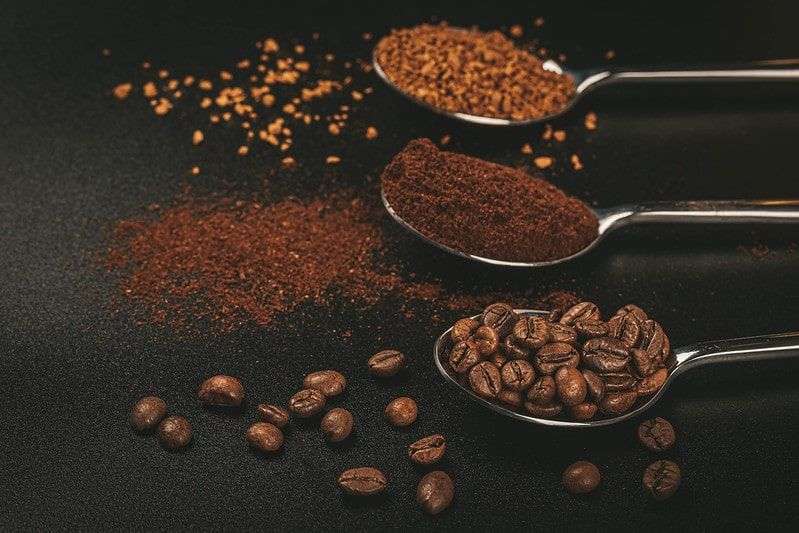Have you ever heard of “Vietnamese instant coffee”? If not, then this article is for you. This article promises to tell you more about vietnamese instant coffee and delicious coffee recipes and brands that you can trust.

Aspects of instant coffee
Instant coffee is a product made from brewed coffee beans that allows consumers to make hot coffee quickly by mixing hot milk or water with powdered or crystalline coffee solids. The item was initially created around 1890 in Invercargill, the biggest city in the New Zealand area of Murihiku. The dehydrated and packaged solids that are sold at retail outlets and used to produce instant coffee are known as instant coffee solids, also known as soluble coffee, coffee crystals, coffee powder, or powdered coffee. Frozen or sprayed-drying processes are used to create instant coffee solids for commercial use, which can subsequently be rehydrated. There are additional factories that produce concentrated liquid instant coffee for beverages.
Instant coffee has several advantages over beans or ground coffee, including speed of preparation (instant coffee dissolves fast in hot water), decreased shipping weight and volume, and a long shelf life, albeit instant coffee can degrade if not kept dry. Since there are no coffee grounds, instant coffee requires less cleanup and, according to at least one study, has a lower environmental impact than drip filter coffee and capsule espresso coffee when compared on the basis of prepared beverages, regardless of the taste and appeal of the beverage produced.
Instant coffee’s heyday
The largest coffee industry bad guy right now is probably instant coffee. Nevertheless, according to Statista, this contentious kind of the black gold we all know and love represents a $15.4 billion market in the United States alone. In fact, many of our friends around the world prefer the substance to freshly roasted coffee beans, including those in Australia, New Zealand, Mexico, Russia, and nearly all of Asia, according to The Washington Post.
Why does instant coffee have such a bad reputation? Know Your Grinder explains that instant java powder is actually manufactured with actual coffee. It is not a replica or a copy. Roasted coffee beans are turned into an extract, which is then condensed and dried using either freeze drying or spray drying. The only thing the coffee crystals require to rehydrate into the fragrant beverage we are accustomed to is hot water or milk.
However, the case against drinking instant coffee continues to be made. Even while there are compelling arguments against it—instant coffee is stronger, contains less caffeine than normal coffee, and has a greater proportion of acrylamide—there are still a number of benefits to choosing it. You might choose instant coffee if you’re camping, traveling, or don’t have access to a coffee maker. We tested some of the most well-known brands and ranked them in order of worst to best only when comparing instant coffee; otherwise, it would be like comparing apples and oranges.

Instant coffee has a poor reputation. When coffee users don’t have time to brew a proper pot in the morning, this is frequently seen as their final resort. What are you unaware of? As more and more individuals started brewing their daily joe at home in 2020, sales of instant coffee experienced a roughly 30% increase.
Early versions of the dissolvable beverage date back to 18th-century Britain, but the concept really took off about 1910 when instant coffee was first offered for sale in a retail setting. Its appeal grew during World War II, and it has subsequently spread to more upscale markets.
The two main production techniques used today are freeze-drying, in which the coffee extract is frozen and subsequently broken up, and spray drying, a quicker and less expensive method in which the coffee extract is sprayed into a hot air chamber. Spray drying uses lower-quality coffee beans, resulting in a less tasty cup of joe.
Even though it’s challenging to find instant coffee that can match freshly made, our round-up will point you in the direction of a cup that comes close. Here are the top instant coffees to buy, whether you’re going camping, traveling, or just want convenience.
What is the procedure for producing instant coffee?
To create 2in1, 3in1, and 4in1 coffee lines, coffee is combined with additional ingredients like sugar and milk cream. Beans are the source of coffee. Superior-quality green coffee (raw coffee beans) is dusted and rinsed. The roasted beans are then turned into instant coffee or ground into a powder for filter coffee.

The majority of the following processes comprise the production of instant coffee:
1. Roast and grind coffee beans
The coffee is immediately roasted after choosing the preferred green coffee beans. International guidelines state that the ideal roasting time for coffee beans is between 18 and 25 minutes per batch, and roasting with cutting-edge technology helps retain the beans’ natural flavor.
There are no bubbles or burned edges, and the coffee beans are cooked evenly from the inside out. The maturity and color of the seeds are constant, irrespective of their size. The next step is to turn the roasted coffee beans into coffee powder. It’s essential that the coffee powder used to make instant coffee is finely ground.
2. Removing
In order to make an extraction solution with a concentration and solubility of between 25 and 35 percent, compounds in coffee must be dissolved in hot water. The system and steps for extracting coffee are as follows:
A temperature-insulated intermittent pyramid-shaped extractor is used to place the coffee first.
Circulate water from the tower’s base that has been heated to between 80 and 90 degrees Celsius in order to extract the coffee.
Dissolvable chemicals will be removed from the coffee in the tower when hot water is applied.
These substances will combine to form a solution at the top of the tower. The tower’s coffee powder will be adjusted on a regular basis to help increase the amount of solute gathered at the top of the tower.
The amount of fine powder that can be thoroughly dissolved in water must be kept to a minimum and the extraction process must be done several times. The content of the coffee extract solution may range from 20 to 22%.
3. Concentrates
We are unable to dry the coffee due to the 20–22% concentration of the coffee solution after extraction. The extract needs to be concentrated to a 30-33% concentration in order to make the drying process easier.
The most common concentration technique is vacuum concentration. putting the coffee solution inside the heater. The coffee water quickly absorbs heat in this situation and evaporates. The barometer’s vacuum will absorb the steam at the condenser, causing it to condense. Up till the proper solution concentration is achieved, the procedure is repeated and then stopped.
4. Dried
The coffee is dried into a powder after concentration to make storage and use easier. The method used the most frequently is spray drying. The top of the cyclo receives an injection of the coffee concentrate.
The base of the cyclo is where the instant coffee powder is gathered. The instant coffee powder is dark brown in color and contains 1% to 2% moisture after drying.
5. Returning home
Coffee’s flavor gradually deteriorates during processing, especially during the high-temperature spray drying process. The chemical elements of the coffee’s scent will be retrieved before extraction and then reintroduced after drying to guarantee that your coffee tastes and smells according to the coffee standard. It’s referred to as repatriation.
The coffee repatriation technology is implemented in two steps.
Desorption, which uses an inert gas to capture a gas mixture, is the first technique. N2 gas and the coffee’s natural scent are combined as a consequence.
Due to the dried coffee powder’s high porosity, it creates the most harmonious composition when it interacts with the gas mixture. We get the final instant coffee powder from this location.

Instant coffee’s flavor in comparison to ground coffee
When instant coffee is packaged, a lot of components of the coffee bean are lost.
During drying and freezing, some of the oils that give coffee its characteristic flavor are lost. Additionally, coffee grounds contain more caffeine, which affects flavor. (It should be noted that Robusta coffees contain more caffeine, which is why they are usually used as instant coffees to make up for caffeine lost during processing.)
In general, the taste of instant coffee is the same regardless of the brand you choose. Most instant coffees taste more bitter than ordinary ground coffee, whether light or dark roasts are utilized. Additionally, it does not go through the same brewing process as the base, where each step affects the flavor. It is regarded as a trade-off between taste and timing.
I wish to share some coffee-making techniques with you.
I start by pouring the sweetened condensed milk into a tall glass to produce my adaptation of iced coffee in the Vietnamese way. I fill the glass with ice and then add strong, freshly brewed coffee on top. For this, fresh coffee can be prepared. Simply give it a vigorous stir to combine the coffee with the sweetened condensed milk and bring it to a cool, pleasant temperature. You then simply top it with your preferred milk, whether it be dairy or dairy-free, and enjoy! If you prefer an iced coffee that is a little richer, you may even add some half & half.
On a hot day, serving family and friends this drink on a patio would be ideal. Just make sure your freezer is stocked with plenty of ice, and you’ll be good to go!
Ca Phe Phin 3 teaspoons of coffee grinds should be added to the Phin, and the filter should be pushed down gently. Place the Phin in front of a glass or cup. Simply moisten the coffee grinds with a small amount of hot water, cover, and let the coffee bloom for five minutes. There shouldn’t be much coffee dripping out just yet. After that, add 1/3 cup of hot water to the blooming coffee grinds and let the coffee gently drip out.
Use a double shot of espresso (about 1/3 cup) each serving when using an espresso machine.
Pour 1/2 a tablespoon of instant coffee granules into 1/3 a cup of boiling water to make instant coffee.
Grab a big glass measuring cup or bowl and scale up the proportions for preparing the coffee for one serving so that you have enough brewed to create several glasses if you intend to serve Vietnamese iced coffee to a number of people.
Above are some things about instant coffee in general and Vietnamese instant coffee in particular. I hope this article is useful and brings you many new things. Thank you for reading and have a nice day.
